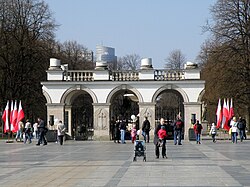Tomb of the Unknown Soldier, Warsaw


Trans.: "Here lies a Polish soldier fallen for the Homeland"

The Tomb of the Unknown Soldier (Polish: Grób Nieznanego Żołnierza) is a monument in Warsaw, Poland, dedicated to the unknown soldiers who have given their lives for Poland. It is one of many such national tombs of unknowns that were erected after World War I, and the most important such monument in Poland.[1]
The monument, located at Piłsudski Square, is the only surviving part of the Saxon Palace that occupied the spot until World War II. Since 2 November 1925 the tomb houses the unidentified body of a young soldier who fell during the Defence of Lwów. Since then, earth from numerous battlefields where Polish soldiers have fought has been added to the urns housed in the surviving pillars of the Saxon Palace.
The Tomb is constantly lit by an eternal flame and assisted by a guard post provided by the three companies of the 1st Guards Battalion, Representative Regiment of the Polish Armed Forces. It is there that most official military commemorations take place in Poland and where foreign representatives lay wreaths when visiting Poland.
The changing of the guard takes place every full hour, 365 days a year.
History
In 1923, a group of unknown Varsovians placed, before Warsaw's
On November 2, 1925, the coffin was brought to Warsaw's
Architecture
The Tomb was designed by the famous Polish sculptor,
During the 1939
After the war, in late 1945, reconstruction began. Only a small part of the palace, containing the Tomb, was restored by Henryk Grunwald. On 8 May 1946 it was opened to the public. Soil from 24 additional battlegrounds was added to the urns, as well as more tablets with names of battles in which Poles had fought in the Spanish Civil War and World War II. However, the government of the Polish People's Republic erased all trace of the Polish–Soviet War of 1920 as a goodwill gesture towards the Soviet Union, and only a few of the Polish Armed Forces' battles in the West were included. In the years following the end of communism in Poland in 1989, the names of Polish-Soviet War battles were restored, the names of Spanish Civil War battles were erased, and tablets containing the names of battles fought by the cursed soldiers were added.
In August 2022 ground works started on rebuilding the Saxon Palace, after the Polish Government announced a plan for reconstruction. It is expected to be completed by 2030.[2]
Battles currently featured on the stone tablets
Gallery
-
Tomb of the Unknown Soldier as a part of the Saxon Palace in 1928
-
An original tablet from the Tomb
-
Tomb of the Unknown Soldier (far right) with (from left)Palace of Culture and Science
-
Saxon Garden, with Tomb in background
-
Monument to the victims of 2010Smolensk air crash, in front of the Tomb of the Unknown Soldier
-
Remains of the Saxon Palace and the Tomb of the Unknown Soldier, 1945, after the destruction of Warsaw
References
- ^ MON (corporate author) (2005-10-24). "Grób Nieznanego Żołnierza". wojsko-polskie.pl (in Polish). Ministry of National Defence. Archived from the original on 2013-04-20. Retrieved 2012-12-26.
{{cite web}}:|author=has generic name (help) - ^ "Poland begins work to rebuild historic Saxon Palace: officials". PolskieRadio.pl. 19 August 2022. Retrieved 7 October 2022.
External links
- Treasures of Warsaw on-line
- (in Polish) The Tomb in 1939 and nowadays
- (in Polish) History of the Tomb
- (in Polish) VIRTUAL TOUR





